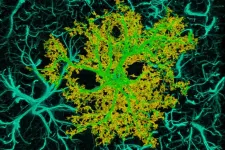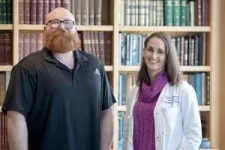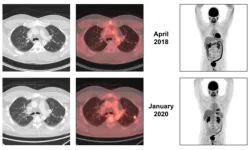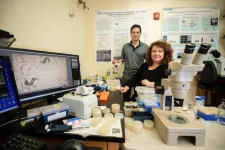(Press-News.org) Researchers in the Department of Anesthesia and Perioperative Medicine at the Medical University of South Carolina (MUSC) have found that an FDA-approved drug may help to decrease pain after surgery. In the pilot study published in Pain Management, spinal surgery patients who received N-acetylcysteine (NAC) during surgery in addition to standard pain control treatments reported lower pain scores and requested fewer opioids after surgery than patients given a placebo.
Opioids are often given for a short time after surgery to treat pain. Although effective, their potency can wain and addictive potential can be dangerous without careful supervision by a health care provider. As such, physicians welcome the opportunity to limit opioid use in managing pain.
“Can we stop giving opiates completely? Likely not. Can we decrease the amount patients need? We should try,” said Sylvia Wilson, M.D., the Jerry G. Reves Endowed Chair in Anesthesia Research in the Department of Anesthesia and Perioperative Medicine and a principal investigator of the study.
Wilson has worked for years on efforts to improve pain management and limit opioid usage after surgical operations. As it turns out, a collaboration with a basic scientist within her own department could offer a solution.
A productive partnership
Wilson began to work closely with Michael Scofield, Ph.D., the Jerry G. Reves Endowed Chair in Basic Science Anesthesiology Research and a senior author of the published study. Scofield has conducted laboratory research on NAC, an anti-inflammatory drug that is used to treat acetaminophen poisoning, mushroom poisoning and liver damage. Researchers, such as Scofield, have also studied its effects on the nervous system, especially in the areas of addiction and pain perception. Wilson’s clinical goals and Scofield’s research on NAC made them ideal collaborators.
“This project is really an elegant synthesis of basic science and clinical research, using things we find have efficacy in the laboratory and taking them to the clinic,” said Scofield.
Wilson believes that partnerships between physicians and basic scientists can spur clinical advances. She credits the supportive environment within the department fostered by Chairman Scott Reeves, M.D., and former College of Medicine Dean Jerry G. Reves, M.D., for making such partnerships possible.
Promising trial insights
The research team chose spinal surgery patients for its pilot study because these patients often experience chronic pain before surgery and are more likely to be exposed to higher levels of opioids before, during and after surgery. During surgery, patients received a standard regimen of anesthesia in addition to a dose of NAC or a saline infusion. Information on patients’ pain and opioid consumption was then collected.
In the 48 hours after surgery, patients who were administered NAC via IV infusion (150 mg/kg) received 19% fewer opioid doses on average than patients who received saline. NAC patients also reported lower pain scores and took a longer time to request pain medication after their surgery than the saline patients. The researchers were especially encouraged to see that the beneficial effect seemed to last longer than the NAC was expected to remain in the body.
“We’ve seen the impact of giving this medication persisting, and I think that’s significant,” said Wilson. “We’re not seeing a rebound effect when that medication wears off.”
This extended effect on pain perception mirrored previous findings from Scofield’s laboratory research.
“For heroin addiction, we had seen in NAC preclinical studies that protection against relapse vulnerability is long lasting,” said Scofield. “Certainly, the hope is that it’s something that has a long duration.”
Looking to the future
Next, the research team wants to investigate whether the findings can be translated to other procedures. They are currently enrolling patients undergoing minimally invasive hysterectomies in a larger trial. As more patients are enrolled, the researchers will be able to conduct more in-depth statistical tests to improve their understanding of the effects of NAC on surgery-associated pain. This will help them to set the stage for future clinical trials of NAC during surgery.
“To change practice, you need many large clinical trials with different settings, different types of surgeries to show that you’re going to cause benefit, not harm,” said Wilson. “We want to show good clinical efficacy, but also safety in that situation.”
# # #
About MUSC
Founded in 1824 in Charleston, MUSC is the state’s only comprehensive academic health system, with a unique mission to preserve and optimize human life in South Carolina through education, research and patient care. Each year, MUSC educates more than 3,200 students in six colleges – Dental Medicine, Graduate Studies, Health Professions, Medicine, Nursing and Pharmacy – and trains more than 900 residents and fellows in its health system. MUSC brought in more than $298 million in research funds in fiscal year 2022, leading the state overall in research funding. MUSC also leads the state in federal and National Institutes of Health funding, with more than $220 million. For information on academic programs, visit musc.edu.
As the health care system of the Medical University of South Carolina, MUSC Health is dedicated to delivering the highest-quality and safest patient care while educating and training generations of outstanding health care providers and leaders to serve the people of South Carolina and beyond. Patient care is provided at 16 hospitals (includes owned and equity stake), with approximately 2,700 beds and four additional hospital locations in development; more than 350 telehealth sites and connectivity to patients’ homes; and nearly 750 care locations situated in all regions of South Carolina. In 2022, for the eighth consecutive year, U.S. News & World Report named MUSC Health University Medical Center in Charleston the No. 1 hospital in South Carolina. To learn more about clinical patient services, visit muschealth.org.
MUSC has a total enterprise annual operating budget of $5.1 billion. The nearly 26,000 MUSC family members include world-class faculty, physicians, specialty providers, scientists, students, affiliates and care team members who deliver groundbreaking education, research, and patient care.
END
Could an already approved drug cut down on opioid use after surgery?
A pilot study conducted by Medical University of South Carolina researchers has found that an FDA-approved drug called NAC could be useful for reducing the need for opioids after spinal surgery
2024-01-12
ELSE PRESS RELEASES FROM THIS DATE:
HOXA9 tracking reveals RBM5 dual function and therapeutic potential for acute myeloid leukemia
2024-01-12
(Memphis, Tenn – January 12th, 2024) The protein HOXA9 is overexpressed in most acute myeloid leukemia (AML) cases and is associated with poor patient outcomes. However, HOXA9 is a difficult protein to target therapeutically, so researchers at St. Jude Children’s Research Hospital looked for ways to extinguish it indirectly. Using CRISPR/Cas9 screening, the researchers identified RBM5, demonstrating a causative link between RBM5 expression and leukemia cell proliferation. This link is driven by a novel dual function of RBM5 as both a DNA and RNA handler ...
Male gender expression in schools is associated with substance abuse later in life
2024-01-12
A new study led by researchers at the University of Chicago found that changes in male gender expression from adolescence to young adulthood align closely with the gender norms present in individuals’ school environments, and that these trajectories are associated with subsequent patterns of substance abuse.
Amidst a growing consensus among social science researchers that separates gender from biological sex, gender has come to be defined as a constellation of expected behaviors, attributes, preferences and beliefs typically associated with a specific gender identity. Prior research shows that traditional models of male gender identity, constructed over time through sociocultural ...
Goldstein selected to help lead statewide task force addressing heart disease and stroke
2024-01-12
LEXINGTON, Ky. (Jan. 12, 2024) — Larry Goldstein, M.D., chair of the University of Kentucky Department of Neurology, has been selected to serve as co-chair of The Kentucky Heart Disease and Stroke Prevention (KHDSP) Task Force representing stroke systems of care across the state.
Goldstein is co-director of the Kentucky Neuroscience Institute, co-director of the UK Neuroscience Research Priority Area, contact PI for the state’s CDC Coverdell National Acute Stroke Program grant, and interim director of the UK-Norton Healthcare Stroke Care Network. Additionally, he also sits on ...
Healthy Hearts for Women event marks 10 years of raising awareness
2024-01-12
LEXINGTON, Ky. (Jan. 12, 2024) — The University of Kentucky will mark a decade of raising awareness and continuing its effort to warn women about the dangers of heart disease with the annual Healthy Hearts for Women Symposium.
Cardiovascular disease is the No. 1 killer of women, causing 1 in 3 deaths each year, according to the American Heart Association. Yet, only 44% of women recognize that cardiovascular disease is their greatest health threat.
“We see the evidence of this devastating statistic right here in Kentucky. The Commonwealth has the highest rates of deaths due to cardiovascular disease in women ...
Building trust and saving lives: A community approach to genetic education
2024-01-12
Changes to DNA, known as mutations, can increase the likelihood of developing cancer. Specifically, people with mutations in their BRCA 1 and 2 genes are substantially more likely to develop hereditary breast and ovarian cancers. But how do people know if they have these mutations?
Genetic testing.
Genetic testing allows doctors to see these microscopic changes. Knowing these mutations exist, doctors will check for signs of breast and ovarian cancers more often.
Yet minorities, especially Black women, are less likely to participate in genetic testing. ...
Using idle trucks to power the grid with clean energy
2024-01-12
University of Waterloo researchers are tapping into idled electric vehicles to act as mobile generators and help power overworked and aging electricity grids.
After analyzing energy demand on Alberta’s power grid during rush hour, the research proposes an innovative way to replenish electrical grids with power generated from fuel cells in trucks.
“Canada’s power grids need to be upgraded,” said Dr. XiaoYu Wu, lead researcher and a professor in Waterloo’s Department of Mechanical and Mechatronics Engineering.
“But the price ...
Activity of pazopanib in EWSR1-NFATC2 translocation-associated bone sarcoma
2024-01-12
“Pazopanib is a multi-kinase inhibitor that is currently approved for treatment of advanced renal cell carcinoma and chemotherapy-refractory soft tissue sarcoma.”
BUFFALO, NY- January 12, 2024 – A new case report was published in Oncoscience (Volume 10) on September 20, 2023, entitled, “Activity of pazopanib in EWSR1-NFATC2 translocation-associated bone sarcoma.”
Pazopanib, a multi-kinase VEGF inhibitor, is currently FDA approved for advanced renal cell carcinoma and advanced soft tissue sarcoma; but limited evidence exists on its efficacy in bone sarcomas.
In this case report, researchers Mohamed A. Gouda, ...
3D in vitro human atherosclerosis model for high-throughput drug screening
2024-01-12
BIRMINGHAM, Ala. – A groundbreaking 3D, three-layer nanomatrix vascular sheet that possesses multiple features of atherosclerosis has been applied for developing a high-throughput functional assay of drug candidates to treat this disease, University of Alabama at Birmingham researchers report in the journal Biomaterials.
“Current in vitro atherosclerosis models have significant limitations, including the lack of three-layer vascular architecture and limited atherosclerotic features,” said Ho-Wook Jun, Ph.D., a professor ...
The early bird (or scientist) gets the worm
2024-01-12
RIVERSIDE, Calif. -- Size does not matter. Certainly not when it comes to tiny worms securing the attention of biologists. One such biologist, Morris F. Maduro at the University of California, Riverside, has just been awarded a grant of nearly $1.3 million from the National Science Foundation, or NSF, to study a worm (or nematode) about a millimeter in length.
The research project will focus on the gut of Pristionchus pacificus. Like most nematodes, P. pacificus develops quickly, its growth from embryo to adult taking just four days. It is a complete ...
News media trigger conflict for romantic couples with differing political views
2024-01-12
CHAMPAIGN, Ill. — By one estimate, as many as 30% of people in the U.S. are in romantic relationships with partners who do not share their political views. In today’s hyperpartisan climate, where Democrats and Republicans have difficulty talking to each other and their views are polarized about media outlets’ credibility, how do couples with differing political perspectives decide which media to follow? And how do these decisions affect their discussions on political issues and their relationship ...
LAST 30 PRESS RELEASES:
Scientists trace microplastics in fertilizer from fields to the beach
The Lancet Obstetrics, Gynecology, & Women’s Health: Taking paracetamol during pregnancy does not increase risk of autism, ADHD or intellectual disabilities, confirms new gold-standard evidence review
Taking paracetamol during pregnancy does not increase risk of autism, ADHD or intellectual disabilities
Harm reduction vending machines in New York State expand access to overdose treatment and drug test strips, UB studies confirm
University of Phoenix releases white paper on Credit for Prior Learning as a catalyst for internal mobility and retention
Canada losing track of salmon health as climate and industrial threats mount
Molecular sieve-confined Pt-FeOx catalysts achieve highly efficient reversible hydrogen cycle of methylcyclohexane-toluene
Investment in farm productivity tools key to reducing greenhouse gas
New review highlights electrochemical pathways to recover uranium from wastewater and seawater
Hidden pollutants in shale gas development raise environmental concerns, new review finds
Discarded cigarette butts transformed into high performance energy storage materials
Researchers highlight role of alternative RNA splicing in schizophrenia
NTU Singapore scientists find new way to disarm antibiotic-resistant bacteria and restore healing in chronic wounds
Research suggests nationwide racial bias in media reporting on gun violence
Revealing the cell’s nanocourier at work
Health impacts of nursing home staffing
Public views about opioid overdose and people with opioid use disorder
Age-related changes in sperm DNA may play a role in autism risk
Ambitious model fails to explain near-death experiences, experts say
Multifaceted effects of inward foreign direct investment on new venture creation
Exploring mutations that spontaneously switch on a key brain cell receptor
Two-step genome editing enables the creation of full-length humanized mouse models
Pusan National University researchers develop light-activated tissue adhesive patch for rapid, watertight neurosurgical sealing
Study finds so-called super agers tend to have at least two key genetic advantages
Brain stimulation device cleared for ADHD in the US is overall safe but ineffective
Scientists discover natural ‘brake’ that could stop harmful inflammation
Tougher solid electrolyte advances long-sought lithium metal batteries
Experts provide policy roadmap to reduce dementia risk
New 3D imaging system could address limitations of MRI, CT and ultrasound
First-in-human drug trial lowers high blood fats
[Press-News.org] Could an already approved drug cut down on opioid use after surgery?A pilot study conducted by Medical University of South Carolina researchers has found that an FDA-approved drug called NAC could be useful for reducing the need for opioids after spinal surgery








